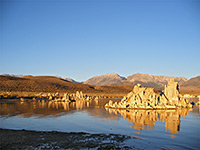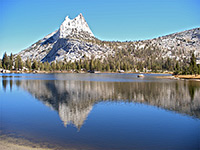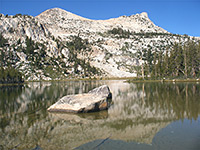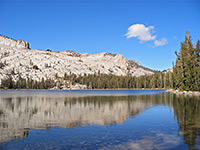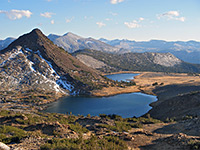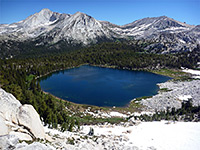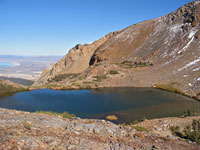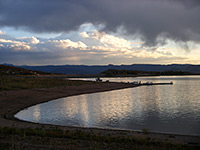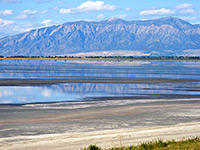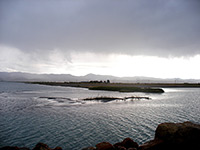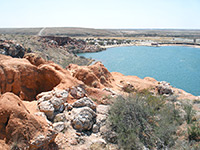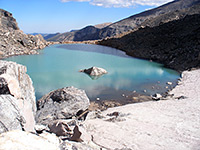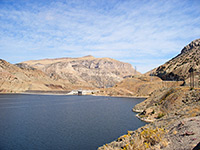Perhaps the most visited lake in California, if not all of the West, and certainly one of the most beautiful, is Lake Tahoe, on the California-Nevada border in the northern Sierra Nevada. Parts of the extensive, wooded shoreline are quite heavily developed but there are plenty of places in a natural state, some contained within state parks like Emerald Bay and Lake Tahoe Nevada, while the high ground to the southwest (Desolation Wilderness) is a renowned hiking destination, containing many smaller lakes surrounded by stark granite scenery, such as Velma and Aloha.
Further afield, two very different lakes, both less than two hour's drive away, are Pyramid (in Nevada) and Mono, this latter close to a number of fascinating volcanic features, while also in the Sierra Nevada are hundreds more Alpine lakes, many within the three main national parks of Kings Canyon, Sequoia and especially Yosemite, of which several dozen are suitable for long or short day hikes, such as the following:
Further north in California are various large reservoirs including three within Whiskytown-Shasta-Trinity National Recreation Area, while just over the border in Oregon, the beautiful Crater Lake is the centerpiece of a national park, welcoming many visitors for the five months of the year that the access roads are not closed by snow. In the Cascade Range of California's far north, another popular group of lakes are within Lassen Volcanic National Park, namely Boiling Springs, Butte, Cold Boiling & Crumbaugh, Ridge, Terrace, Cliff & Shadow. In contrast there are very few lakes in the desert areas of California, the main exception being the Salton Sea in the far southeast; this is a strange, rather forlorn location, though a good subject for photography.
The western border of Arizona is formed by the great Colorado River, which over its 1,450 mile length is dammed to form six lakes - Mead (partly in Nevada) and Powell (mostly in Utah) are the largest, while the others are Mohave, Havasu, and, at the far upstream end, Shadow Mountain and Granby which are part of Arapaho National Recreation Area in Colorado. More Arizona lakes are found in the cactus-covered hills around Phoenix: Alamo, Bartlett, Pleasant, San Carlos, Theodore Roosevelt, and several on the Salt River alongside the Apache Trail. Others include Watson Lake near Prescott, surrounded by huge rounded granite boulders, and Patagonia Lake in the far south, notable for its diverse wildlife.
Besides Lake Powell, Utah contains the Great Salt Lake (seen most readily at Antelope Island State Park) or along Interstate 80, Provo Lake and the southern sections of Flaming Gorge Reservoir and Bear Lake; all others, mostly in the mountains, are relatively small but Lake Powell has to be the most photogenic anywhere in the Southwest, and although the majority of its shoreline is quite inaccessible, paved roads do lead to the water's edge at Wahweap near Page, Bullfrog, Halls Crossing and Hite.
New Mexico has no major natural lakes, just those created by river dams, including Navajo, Elephant Butte, Caballo and Abiquiu. There are various smaller riparian areas scattered across the state such as Roswell's Bottomless Lakes (a chain of flooded limestone sinkholes) and Bosque del Apache National Wildlife Refuge along the Rio Grande. Colorado also has its share of reservoirs, and while there are no especially large lakes, the Rocky Mountains contain numerous pretty ponds, some of the most accessible being in Rocky Mountain National Park, such as Bierstadt, Chasm, Gem, Timber, Ypsilon/Spectacle and Bear, Nymph, Dream, Andrews & The Loch. Three particularly beautiful lakes in the San Juan Mountains (Ice, Fuller, Island), each diffrent in character, may be visited by a relatively easy trail starting near Silverton.
Further north along the Rocky Mountains, Wyoming has a selection of branched reservoirs, largest being Flaming Gorge, Boysen, Pathfinder, Seminole and others in the northeast, but the two most famous lakes are Yellowstone and Jackson, this latter being one of the main features of Grand Teton National Park. Together with adjacent Yellowstone National Park, these two contain numerous backcountry lakes reached by easy trails including:
View all photographs of lakes.
Further afield, two very different lakes, both less than two hour's drive away, are Pyramid (in Nevada) and Mono, this latter close to a number of fascinating volcanic features, while also in the Sierra Nevada are hundreds more Alpine lakes, many within the three main national parks of Kings Canyon, Sequoia and especially Yosemite, of which several dozen are suitable for long or short day hikes, such as the following:
- Sequoia - Heather, Aster, Emerald, Pear Lakes
- Yosemite - Cathedral Lakes
- Yosemite - Dog Lake
- Yosemite - Elizabeth Lake
- Yosemite - Gaylor Lakes
- Yosemite - Lower Gaylor Lake
- Yosemite - Lukens Lake
- Yosemite - May Lake
- Yosemite - Mirror Lake
- Yosemite - Polly Dome Lakes
- Yosemite - Sunrise Lakes
- Yosemite - Upper Sardine Lake
- Yosemite - Young Lakes
The western border of Arizona is formed by the great Colorado River, which over its 1,450 mile length is dammed to form six lakes - Mead (partly in Nevada) and Powell (mostly in Utah) are the largest, while the others are Mohave, Havasu, and, at the far upstream end, Shadow Mountain and Granby which are part of Arapaho National Recreation Area in Colorado. More Arizona lakes are found in the cactus-covered hills around Phoenix: Alamo, Bartlett, Pleasant, San Carlos, Theodore Roosevelt, and several on the Salt River alongside the Apache Trail. Others include Watson Lake near Prescott, surrounded by huge rounded granite boulders, and Patagonia Lake in the far south, notable for its diverse wildlife.
Besides Lake Powell, Utah contains the Great Salt Lake (seen most readily at Antelope Island State Park) or along Interstate 80, Provo Lake and the southern sections of Flaming Gorge Reservoir and Bear Lake; all others, mostly in the mountains, are relatively small but Lake Powell has to be the most photogenic anywhere in the Southwest, and although the majority of its shoreline is quite inaccessible, paved roads do lead to the water's edge at Wahweap near Page, Bullfrog, Halls Crossing and Hite.
New Mexico has no major natural lakes, just those created by river dams, including Navajo, Elephant Butte, Caballo and Abiquiu. There are various smaller riparian areas scattered across the state such as Roswell's Bottomless Lakes (a chain of flooded limestone sinkholes) and Bosque del Apache National Wildlife Refuge along the Rio Grande. Colorado also has its share of reservoirs, and while there are no especially large lakes, the Rocky Mountains contain numerous pretty ponds, some of the most accessible being in Rocky Mountain National Park, such as Bierstadt, Chasm, Gem, Timber, Ypsilon/Spectacle and Bear, Nymph, Dream, Andrews & The Loch. Three particularly beautiful lakes in the San Juan Mountains (Ice, Fuller, Island), each diffrent in character, may be visited by a relatively easy trail starting near Silverton.
Further north along the Rocky Mountains, Wyoming has a selection of branched reservoirs, largest being Flaming Gorge, Boysen, Pathfinder, Seminole and others in the northeast, but the two most famous lakes are Yellowstone and Jackson, this latter being one of the main features of Grand Teton National Park. Together with adjacent Yellowstone National Park, these two contain numerous backcountry lakes reached by easy trails including:
- Grand Teton - Amphitheater Lake
- Grand Teton - Emma Matilda Lake
- Grand Teton - Jackson Lake - Hermitage Point
- Grand Teton - Jackson Lake - Lakeshore Trail
- Grand Teton - Taggart Lake and Bradley Lake
- Yellowstone - Duck Lake
- Yellowstone - Harlequin Lake
- Yellowstone - Heart Lake
- Yellowstone - Ice Lake
- Yellowstone - Lost Lake
- Yellowstone - Ribbon Lake
- Yellowstone - Riddle Lake
- Yellowstone - Shoshone Lake
- Yellowstone - Turbid Lake
- Yellowstone - Yellowstone Lake (Overlook Trail)
- Yellowstone - Yellowstone Lake (Pelican Creek)
- Yellowstone - Yellowstone Lake (Storm Point)
View all photographs of lakes.
All Contents © Copyright The American Southwest | Comments and Questions | Contribute | Affiliate Marketing Disclosure | Site Map



